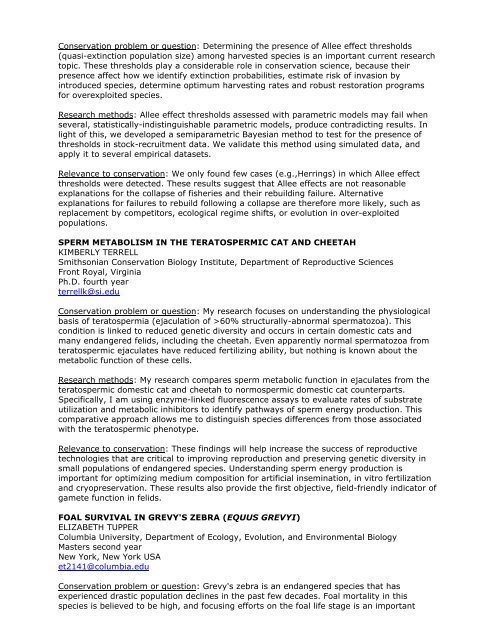Poster Abstracts in Word 29oct - American Museum of Natural History
Poster Abstracts in Word 29oct - American Museum of Natural History
Poster Abstracts in Word 29oct - American Museum of Natural History
Create successful ePaper yourself
Turn your PDF publications into a flip-book with our unique Google optimized e-Paper software.
Conservation problem or question: Determ<strong>in</strong><strong>in</strong>g the presence <strong>of</strong> Allee effect thresholds(quasi-ext<strong>in</strong>ction population size) among harvested species is an important current researchtopic. These thresholds play a considerable role <strong>in</strong> conservation science, because theirpresence affect how we identify ext<strong>in</strong>ction probabilities, estimate risk <strong>of</strong> <strong>in</strong>vasion by<strong>in</strong>troduced species, determ<strong>in</strong>e optimum harvest<strong>in</strong>g rates and robust restoration programsfor overexploited species.Research methods: Allee effect thresholds assessed with parametric models may fail whenseveral, statistically-<strong>in</strong>dist<strong>in</strong>guishable parametric models, produce contradict<strong>in</strong>g results. Inlight <strong>of</strong> this, we developed a semiparametric Bayesian method to test for the presence <strong>of</strong>thresholds <strong>in</strong> stock-recruitment data. We validate this method us<strong>in</strong>g simulated data, andapply it to several empirical datasets.Relevance to conservation: We only found few cases (e.g.,Herr<strong>in</strong>gs) <strong>in</strong> which Allee effectthresholds were detected. These results suggest that Allee effects are not reasonableexplanations for the collapse <strong>of</strong> fisheries and their rebuild<strong>in</strong>g failure. Alternativeexplanations for failures to rebuild follow<strong>in</strong>g a collapse are therefore more likely, such asreplacement by competitors, ecological regime shifts, or evolution <strong>in</strong> over-exploitedpopulations.SPERM METABOLISM IN THE TERATOSPERMIC CAT AND CHEETAHKIMBERLY TERRELLSmithsonian Conservation Biology Institute, Department <strong>of</strong> Reproductive SciencesFront Royal, Virg<strong>in</strong>iaPh.D. fourth yearterrellk@si.eduConservation problem or question: My research focuses on understand<strong>in</strong>g the physiologicalbasis <strong>of</strong> teratospermia (ejaculation <strong>of</strong> >60% structurally-abnormal spermatozoa). Thiscondition is l<strong>in</strong>ked to reduced genetic diversity and occurs <strong>in</strong> certa<strong>in</strong> domestic cats andmany endangered felids, <strong>in</strong>clud<strong>in</strong>g the cheetah. Even apparently normal spermatozoa fromteratospermic ejaculates have reduced fertiliz<strong>in</strong>g ability, but noth<strong>in</strong>g is known about themetabolic function <strong>of</strong> these cells.Research methods: My research compares sperm metabolic function <strong>in</strong> ejaculates from theteratospermic domestic cat and cheetah to normospermic domestic cat counterparts.Specifically, I am us<strong>in</strong>g enzyme-l<strong>in</strong>ked fluorescence assays to evaluate rates <strong>of</strong> substrateutilization and metabolic <strong>in</strong>hibitors to identify pathways <strong>of</strong> sperm energy production. Thiscomparative approach allows me to dist<strong>in</strong>guish species differences from those associatedwith the teratospermic phenotype.Relevance to conservation: These f<strong>in</strong>d<strong>in</strong>gs will help <strong>in</strong>crease the success <strong>of</strong> reproductivetechnologies that are critical to improv<strong>in</strong>g reproduction and preserv<strong>in</strong>g genetic diversity <strong>in</strong>small populations <strong>of</strong> endangered species. Understand<strong>in</strong>g sperm energy production isimportant for optimiz<strong>in</strong>g medium composition for artificial <strong>in</strong>sem<strong>in</strong>ation, <strong>in</strong> vitro fertilizationand cryopreservation. These results also provide the first objective, field-friendly <strong>in</strong>dicator <strong>of</strong>gamete function <strong>in</strong> felids.FOAL SURVIVAL IN GREVY'S ZEBRA (EQUUS GREVYI)ELIZABETH TUPPERColumbia University, Department <strong>of</strong> Ecology, Evolution, and Environmental BiologyMasters second yearNew York, New York USAet2141@columbia.eduConservation problem or question: Grevy's zebra is an endangered species that hasexperienced drastic population decl<strong>in</strong>es <strong>in</strong> the past few decades. Foal mortality <strong>in</strong> thisspecies is believed to be high, and focus<strong>in</strong>g efforts on the foal life stage is an important
















